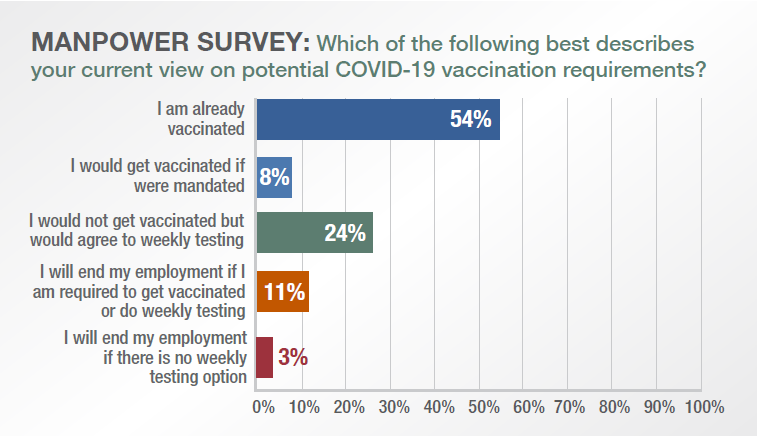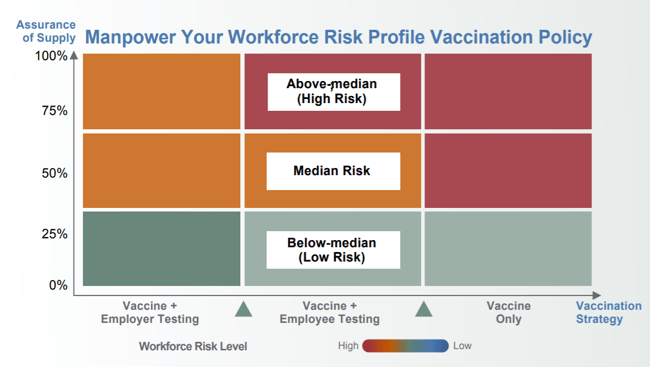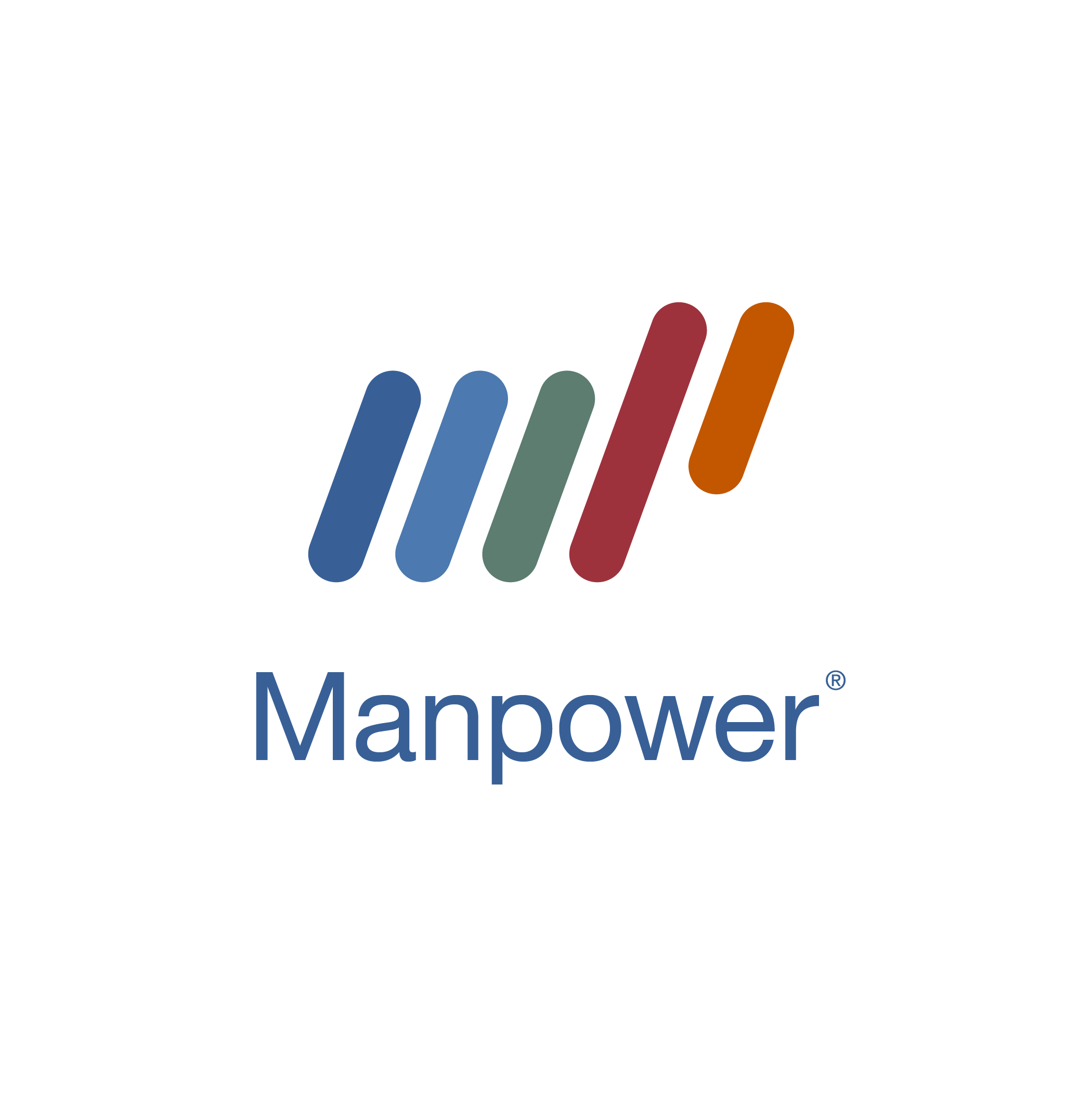
If you prefer, you can download the PDF
of this Talent Pulse Briefing.
A new federal mandate will require COVID-19 vaccinations and/or regular testing in the very near future. The time to plan is now. Creating a strong strategy in advance will save you time, minimize confusion among employees and give your organization the ability to prepare to meet the new requirements. Many major companies are already implementing vaccination and/or testing requirements, and vaccination rates are starting to rise.
As a global leader in workforce solutions, Manpower is well positioned to help you plan for the future and what factors your company should consider to prepare a workforce strategy for the new next.
The mandate and why it matters
The Department of Labor’s Occupational Safety and Health Administration (OSHA) has developed an emergency temporary standard that will require all employers with 100 or more employees to ensure their workforce is fully vaccinated by January 4, 2022 or require any workers who remain unvaccinated to wear masks and produce a negative Covid-19 test result on at least a weekly basis. This rule would apply to everyone working for the company; however those who work from home, at a site with no other employees, or outdoors are not subject to the new ETS. (Note: This is in addition to the Executive Order requiring all federal employees and contractors to be vaccinated.) The order also stipulates that companies must develop, publish, implement and enforce a vaccination policy by December 5, 2021.
Opinions on vaccines vary greatly across communities and demographics
• Currently, 67% of individuals 12 and over in the U.S. are fully vaccinated.
• Location matters: As of August, 45.8% of adults in rural counties had been fully vaccinated, compared to 59.8% in urban counties.
• Lower income groups are less likely to be vaccinated according to Medicaid statistics.
In August 2021, Manpower conducted a survey of 6,644 workers in the U.S., of which the average hourly wage was at or around $16, and we found a sizable group (38%) showing vaccine hesitancy (see chart below). Of states with more than 30 total responses, Wyoming, Indiana, and Oklahoma have the highest percentage of respondents who reported that they would end their employment if required to get vaccinated or do weekly testing. We also found that employees working in wholesale trade, utilities and food services are more likely to end employment if a vaccine is mandated at their workplace.

Job openings are increasing, but there are fewer people
to fill them.
We’re seeing the perfect storm of increasing demand and low labor force participation. Employers should expect labor disruptions to continue for the foreseeable future, and here’s why:
- The global talent shortage is still very high — the highest level in 15 years — and we’re seeing demand increasing in e-commerce, travel, leisure and hospitality as businesses are reopening and people begin to get back to their pre-COVID routines.
- Since the pandemic began, the labor force participation rate — the share of people 16 and over who are either working or looking for work — has remained well below what it was 20 years ago. Some economists think that this shortage will continue for years.
- Seasonal hiring is just ramping up. Deloitte reports expecting holiday retail sales to increase 7-9%, with e-commerce holiday sales projected to grow 11% to 15%, compared to the 2020 season. This will put pressure on organizations that need to ramp up their logistics and distribution workforce in an already tight labor market.
- There are strong worker preferences at play including a desire for more work/life balance and greater flexibility in when and where work happens, in addition to preferences regarding the vaccine and other safety requirements. This means workers are being extra selective when choosing where to work.
There are three mandate options (listed from most to least restrictive)
- Vaccine only – Workers are required to be fully vaccinated (exemptions for medical or religious reasons).
- Vaccine OR frequent employee-paid testing – Workers who don’t want vaccination must be tested weekly and must pay for testing.
- Vaccine OR frequent employer-paid testing – Workers who don’t want vaccination must be tested weekly and employer pays.
Steps to Build Your Vaccine Mandate Workforce Strategy
- Build Awareness:
Initiate this immediately if you haven’t already. The CDC and health care
providers have helpful information about variants, transmission, vaccines and vaccination sites. There may also be state or local vaccine incentives. - Survey Your Workers:
Understanding the preferences of your workforce will be a critical component in crafting your plan. This insight provides you with not only input to your plan but an opportunity for your workforce to be heard during the process. See information about our internal survey on page one. - Assess Your Situation:
Review your current vaccination rates and the results of your preferences survey. This information will help you determine how much risk you may be facing in the way of labor disruption. If there is a higher-than-average rate of vaccine hesitancy in your area, it may affect turnover or new hires. If not fully staffed, you may not be able to meet your customer commitments.
The Manpower Vaccine Workforce Decision Framework is designed to help you evaluate
trade-offs and plot your course forward. It includes a 9-box matrix that will help you plot the number of workers you need daily to meet customer demand, taking into account both workforce availability and your vaccination/testing strategy.
Factors to help determine your assurance of (labor) supply and your workforce risk profile:
Risk tolerance: What are your customer commitments? What are your business continuity plans? What would the impact be if you shed products, reduced output or shifted production locations?
Sensitivity to turnover: Will workers walk if they don’t want to comply with a mandate? Will workers choose to leave if they don’t feel safe at work?
Location and population of workforce: What are the general attitudes toward vaccines and the vaccine mandate in your community? A good guidepost for gauging this could be your county’s current rate of vaccination. These figures are available for all U.S. counties on the CDC website.
Current competitiveness: Your competitors’ approach to workforce is an important factor for consideration. How competitive are you really? Consider their plans as well as elements such as increased pay rates and added benefits that could be deciding factors for new job candidates and influence whether your existing workforce stays or goes. - Design Your Strategy.
Based on your risk profile, choose the mandate option that seems best for you and your
workforce. (See 1, 2, and 3 above.)
Boost your recruit/refill strategy: Meet adversity with diversity by expanding to omni-channel delivery in these three ways:
– Prioritize your community presence to maximize your local attraction opportunities.
– Make the recruiting process convenient by going to the talent.
– Make investments where it counts by leveraging custom technology solutions, dedicated recruiters, and private talent pools.
Become an employer of choice: Becoming the company everyone wants to work for is often easier said than done, but there are practical, achievable ways you can do just that. Here five main categories for you to consider when creating your approach:
– Increase ease of entry – Give candidates the fastest, easiest experience from application to day one on the job. Find bottlenecks and make it a priority to fix them.
–Have a clear employer value proposition – Today’s workers are looking for more than wages, they want to know about your company culture, its mission and more.
–Boost benefits – Today, companies are finding that benefits mean much more than health insurance. Competitive organizations think outside of the box on what falls under this umbrella.
–Be flexible – Flexible work options that emerged during the pandemic are now desirable to candidates long term. In a survey of U.S. workers by ManpowerGroup, 80% want options to work outside the office while another 63% want flexible hours. What flexibility do you have on your team?
–Recognize your team members – Individual performance recognition remains key to employee retention. Employees want to know their work means something. - Communicate, Communicate, Communicate.
This step should start even before your plan is fully formed. According to a recent McKinsey & Company report, nearly half of employees in organizations that are communicating vaguely, or not at all, about the future of post-pandemic work, say it’s causing them anxiety. This type of anxiety often affects morale and work performance and increases burnout.
Develop a communication plan based on your strategy rollout timeline or estimated date mandates would go into effect – whichever comes first. Let your entire workforce know what to expect, what is most important for them to know, how to best prepare for any changes, and when they can expect the new changes to take effect. - Measure and react.
Once your plan is in place, you can measure its effectiveness by keeping track of on-time starts, turnover and overtime based on baseline figures. Our Manpower workforce tools help companies understand how to react and ultimately lower their workforce costs.

.jpg)



-3.png?length=800&name=MicrosoftTeams-image%20(4)-3.png)
Comments